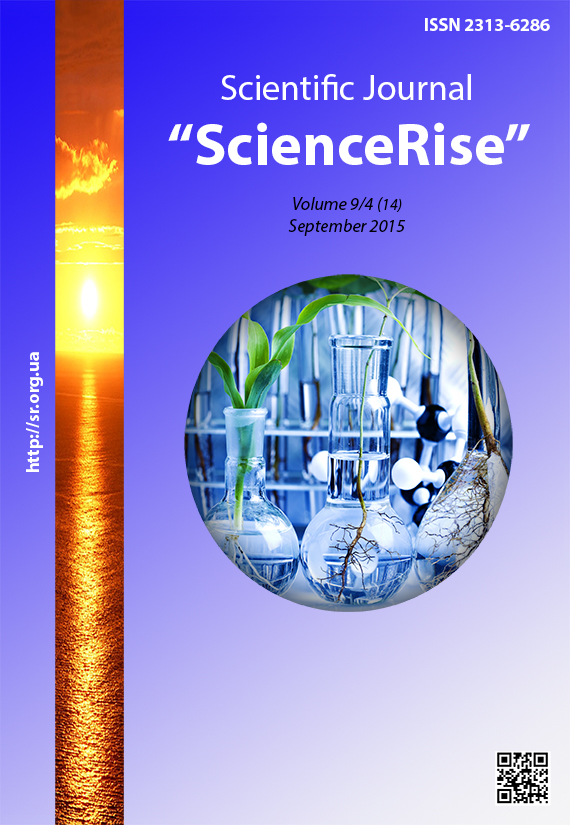Features of cardiac hemodynamics at chronic heart failure with overweight and obesity depending on the functional state of the kidneys
DOI:
https://doi.org/10.15587/2313-8416.2015.50210Keywords:
kidneys functional state, chronic heart failure, cardiac hemodynamics, overweight, obesityAbstract
Several researches had demonstrated connection between the kidney dysfunction and worse prognosis in patients with both acute and chronic heart failure (CHF). The aim of research was to study the special features of cardiac hemodynamics at CHF with overweight and obesity depending on functional state of kidneys.
Methods. There were examined 347 patients with CHF 0f 1-111 functional class on the background of overweight and abdominal obesity of 1-111 degree and different functional state of kidneys. There was calculated the speed of glomerular filtration (on MDRD formula) and carried out Doppler echocardiography for all examined persons. There was used an unpaired Student t-criterion or Mann-Whitney U-criterion depending on the size of sample and distribution of indicators.
Results. Concomitant kidney functional state disorder complicates the clinical course of CHF on the background of overweight and obesity. It is demonstrated as an increase of functional class of disease at moderate and heavy kidney dysfunction. It is based on an increase of the degree of dilatation of the left and right atrium, left ventricle (LV) and the more degree of myocardium hypertrophy. The more significant calcination of mitral and aortic valves, the growth of degree of mitral regurgitation takes place. Simultaneously with structural changes in heart there take place functional disorders namely the worsening of contractility of LV and spread of systolic and diastolic myocardium function of 1 type, development of kidney hypertension. The remodeling of myocardium in this category of patients is mainly presented as concentric hypertrophy although at progression of kidney dysfunction the tendency to gradual elevation of excentric hypertrophy of LV takes place.
Conclusions: It was established that CHF on the background of overweight and obesity associated with kidney dysfunction is characterized with heavier clinical course, elder age and more representation of women, dilatation of heart chambers, progression of hypertrophy of LV, calcination of valves and complication of mitral regurgitation. There took place a decrease of contractility of LV and spread of systolic and diastolic function by the type of relaxation disorder, kidney hypertension was forming. Among the types of myocardium remodeling the most widespread is concentric hypertrophy of LV that tends to decrease in favor of ecxentric hypertrophy at intensification of kidney dysfunction
References
Shiba, N., Shimokawa, H. (2011). Chronic kidney disease and heart failure – Bidirectional close link and common therapeutic goal. Journal Of Cardiology, 57 (1), 8–17. doi: 10.1016/j.jjcc.2010.09.004
Konstam, M. A. (2011). Renal Function and Heart Failure Treatment: When Is a Loss Really a Gain? Circulation: Heart Failure, 4 (6), 677–679. doi: 10.1161/circheartfailure.111.964874
Hillege, H. L., Nitsch, D., Pfeffer, M. A., Hillege, H. L., Nitsch, D., Pfeffer, M. A. et. al (2006). Renal Function as a Predictor of Outcome in a Broad Spectrum of Patients With Heart Failure. Circulation, 113 (5), 671–678. doi: 10.1161/circulationaha.105.580506
De Silva, R., Nikitin, N. P., Witte, K. K. et. al (2006). Incidence of renal dysfunction over 6 months in patients with chronic heart failure due to left ventricular systolic dysfunction: contributing factors and relationship to prognosis. European Heart Journal, 27 (5), 569–581. doi: 10.1093/eurheartj/ehi696
Schou, M., Kjaergaard, J., Torp-Pedersen, C., Hassager, C., Gustafsson, F. et. al (2013). Renal dysfunction, restrictive left ventricular filling pattern and mortality risk in patients admitted with heart failure: a 7-year follow-up study. BMC Nephrology, 14 (1), 267. doi: 10.1186/1471-2369-14-267
De Silva, R., Rigby, A. S., Witte, K. K. A., Nikitin, N. P., Tin, L., Goode, K. et. al (2006). Anemia, Renal Dysfunction, and Their Interaction in Patients With Chronic Heart Failure. The American Journal of Cardiology, 98 (3), 391–398. doi: 10.1016/j.amjcard.2006.01.107
Windram, J. D., Loh, P. H., Rigby, A. S., Hanning, I., Clark, A. L., Cleland, J. G. F. (2007). Relationship of high-sensitivity C-reactive protein to prognosis and other prognostic markers in outpatients with heart failure. American Heart Journal, 153 (6), 1048–1055. doi: 10.1016/j.ahj.2007.03.044
Smilde, T. D. J., Hillege, H. L., Navis, G., Boomsma, F., de Zeeuw, D., van Veldhuisen, D. J. (2004). Impaired renal function in patients with ischemic and nonischemic chronic heart failure: association with neurohormonal activation and survival. American Heart Journal, 148 (1), 165–172. doi: 10.1016/j.ahj.2004.02.007
Voronkov, L. H. et al. (2013). Rekomendacii po diahnostike I lecheniu khronicheskoi serdechnoi nedostatochnosti (2012) [Guidelines for the diagnosis and treatment of chronic heart failure (2012)]. Ukrainian cardiology journal, 1, 6–44.
Lashkul, D. A. (2014). Vikovi osoblyvosti remodeliuvania miokarda u cholovikiv iz khronicheskoiu sercevoiu nedostatnistyu ishemichnoho henezu ta nyrkovoiu dycfunkcieiu [Age features of myocardial remodeling in men with ischemic chronic heart failure and renal dysfunction]. Patolohia. Pathology, 1 (30), 12–15.
Downloads
Published
Issue
Section
License
Copyright (c) 2015 Петро Петрович Бідзіля

This work is licensed under a Creative Commons Attribution 4.0 International License.
Our journal abides by the Creative Commons CC BY copyright rights and permissions for open access journals.
Authors, who are published in this journal, agree to the following conditions:
1. The authors reserve the right to authorship of the work and pass the first publication right of this work to the journal under the terms of a Creative Commons CC BY, which allows others to freely distribute the published research with the obligatory reference to the authors of the original work and the first publication of the work in this journal.
2. The authors have the right to conclude separate supplement agreements that relate to non-exclusive work distribution in the form in which it has been published by the journal (for example, to upload the work to the online storage of the journal or publish it as part of a monograph), provided that the reference to the first publication of the work in this journal is included.

